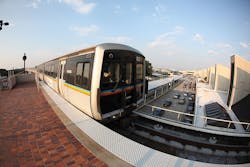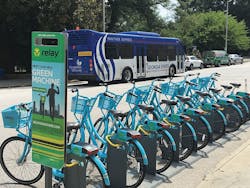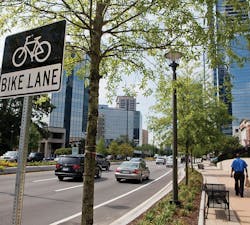How the Metro Atlanta region is planning for transportation over the next three decades
By: Tim Bruns
The Metro Atlanta region in northwest Georgia is one of the fastest growing regions in the country, serving as home to 6 million people and boasting the ninth largest metropolitan area in the U.S.
As this region expects to see a population increase of nearly 3 million people by the year 2050, transportation planners with the Atlanta Regional Commission (ARC) are preparing to accommodate this influx with an approximately $173 billion Regional Transportation Plan (RTP) for Metro Atlanta.
“We’ve crafted a regional transportation plan around trying to address not only the current conditions that we have—which we have a lot of needs ranging from improving safety to helping address congestion to expanding transit—but also working to help address the future growth,” John Orr, manager of the Transportation Access and Mobility Group with ARC, told Roads & Bridges.
FACTORS CONTRIBUTING TO POPULATION GROWTH
According to ARC, the anticipated growth of the region is largely driven by business expansion and economic growth. According to the RTP, employment for the 20-county region is projected to increase by 1.2 million jobs between 2015 and 2050. In total, the region expects 33% employment growth during this time period.
The RTP also says growth in two sectors is expected to greatly outpace growth in other sectors. The Health Care and Social Assistance sector is expected to grow the most by 2050, expanding by almost 74% or nearly a quarter of a million jobs. The Construction sector is expected to grow at the second highest rate, adding 69% more jobs (about 131,000) by 2050. In addition, growth in the Retail sector, the Professional, Scientific, and Technical Services sector, and the Administrative and Waste Management sector are all projected to be above 100,000 jobs added by 2050.
“One of the factors seems to be that Georgia has historically been a good climate for companies to locate,” Orr explained. “There’s a lot of years that Georgia’s been the number one place in the country, according to some publications, to do business.”
Rosalind Tucker, managing director of the ARC’s Mobility Services Group, explained that college and university graduates in the region are choosing to stay in the area as a result of the expanded employment opportunities in the region. “We used to see them graduate from our universities and then go out to Silicon Valley or other places,” Tucker told Roads & Bridges. “And now there’s a great opportunity for them to stay in Atlanta, particularly when you have Google setting up here and Amazon. So there are a lot more tech-related jobs in the region as well.” Tucker also explained that the Metro Atlanta region has seen an increase in people relocating to the area in the last year during the pandemic.
ARC says the population growth over the next 30 years is expected to be spread out across the region, with all counties projected to experience a population increase of at least 25%. “With population growth expected across Metro Atlanta, pressure on our current transportation system will only increase, and the demand for transportation options will rise,” the RTP said. “The majority of the region’s residents work outside of the county they live in, and mobility across and around Metro Atlanta is critical for the success of the region.”
How COVID is impacting transportation planning
As the COVID-19 pandemic led many companies across the country—including in Metro Atlanta—to shift to a remote work model for non-essential employees, transportation and congestion management planners have been keeping an eye on how a more permanent teleworking trend may affect traffic patterns in the long-term.
Georgia Commute Options—a program managed by ARC that works with employers, commuters, and schools to reduce the number of single-occupant vehicles on Metro Atlanta’s roads—partners with over 800 employers in the region, which accounts for about 350,000 commuters. A large share of commuters in the region actively use the program’s online app to log their commute, which allows the Mobility Services Group to extrapolate commuting data.
“Pre-COVID, on average, most of the companies had over 4,000 respondents, and the majority of them were barely teleworking one day a week,” Tucker said. “During COVID it went up to five days. And now we’ve been surveying every three months since April 2020, so we have a full year’s collection of surveys. And folks are still teleworking at about 3.9 days per week.”
Tucker explained that in the early days of the pandemic, approximately 71% of the surveyed companies had their employees teleworking full time. In October 2020, that number went down to 63%, but has come back up to 66% as of April 2021, showing an overall steady rate for teleworking companies since the beginning of the pandemic.
The Mobility Services Group has looked at commuting and congestion from several transportation modes, including transit, carpooling, biking, and walking. The region saw a decline in transit use last year, but is beginning to see an uptick again, while carpool and vanpool use is climbing. Tucker said the last 3-4 years have seen a 30% decrease in vanpool use, but a 17% increase over just the last few months. Carpools and vanpools are examples of non-single-occupancy vehicle (SOV) use that the Georgia Commute Options program is encouraging commuters and employers to take advantage of in the Metro Atlanta area.
Over the next few years, the Mobility Services Group will keep an eye on how long-term teleworking trends might impact traffic congestion in the region. The ARC updates its traffic demand management (TDM) plan every few years, and one of the main considerations will be how teleworking will factor into the plan, particularly if the high percentage of teleworking is long-term. “We would be excited to see even more incentives around making this more long-term because this could—and it has for a year—create solutions to the congestion challenge, and the opportunities we have for the region,” Tucker explained.
Plans to boost mobility
For the near future, Atlanta’s Regional Transportation Plan includes about $102 billion earmarked to maintain and upgrade infrastructure already in place. This amounts to roughly 60% of the total funding in the RTP. Maintenance projects include resurfacing roads, repairing bridges, and replacing aging buses and rail cars, as well as new technology designed to improve safety and traffic flow by connecting vehicles to “smart” traffic signals.
According to Orr, one of the major pillars of the RTP is addressing existing and future congestion bottlenecks. The plan provides about $27 billion for key interchange and highway improvements throughout Metro Atlanta. Some of the major highway projects due to start construction in the next decade include managed lanes on the top-end Perimeter, I-285 East, and I-285 West; reconstruction of I-285 North at Ga. 400 in Fulton; and a new interchange at I-85 North at McGinnis Ferry Road in Gwinnett.
The RTP also includes 215 arterial widenings and other projects that will add a total of about 600 lane-miles of capacity to the region’s arterial network by 2050. Anticipated projects over the next decade include widening Piedmont Road from Lenox Road to Peachtree Road in the city of Atlanta as well as widening S.R. 85 from Old National Highway in Fayette County to Roberts Drive in Riverdale.
The ARC said the Metro Atlanta region has “strong but geographically limited transit options.” One reason for this, Orr explained, is that the Metropolitan Atlanta Rapid Transit Authority (MARTA), the core transit system of the region, was only focused on two counties (Fulton and DeKalb) for nearly 40 years up until 2014.
“That really did set us behind because over the past 30 years, the bulk of the population growth was in the counties that were outside of MARTA—such as Gwinnett County and Cobb County,” Orr said. “So ultimately we have these large suburban communities of population centers that are not connected into our premium transit network. We ultimately want to be able to tie high-quality transit into our heavy rail network. And that’s a heavy emphasis area for our planning to ultimately be able to provide high-capacity transit services to our suburban communities, while at the same time improving transit services in the core of the region and the city of Atlanta.”
To address this need, Metro Atlanta’s RTP includes $11 billion for new transit options. Some transit projects expected in the next decade include high capacity transit in Clayton County, phase 1 of which will connect Jonesboro to the East Point MARTA station; expansion of Atlanta’s streetcar network from Jackson St. to Ponce de Leon Ave.; and a bus rapid transit line to connect the growing Georgia State University Stadium area in Summerhill to the MARTA rail network to the north and the Atlanta BeltLine to the south.
In addition to expanded transit options, the ARC is looking to dedicate about $10 billion to projects and programs that reduce congestion by encouraging mobility alternatives, including micro-mobility and micro-transit options. This includes expanding the region’s bike-ped trails to provide new ways of getting around without driving.
“Local governments, ARC, and transit operators are currently implementing bike-share projects around the region,” Orr said. “This program is an important part of the overall vision for the future. Micro-mobility, including pilot transit projects, will be one of the major ways that transit refocuses services in the future. Gwinnett County—a large suburban county of about 1 million—continues to implement micro-transit services, and the flexibility of the routes provides strong services for many lower-density suburban communities.”
Reducing travel demand
The Mobility Services Group aims to change travel behavior in the region through transportation demand management. This work includes reducing roadway congestion and demand for SOV travel by redistributing travel demand to non-SOV modes. The program offers incentives and programs that encourage SOV drivers to take transit, telework, carpool, vanpool, walk, or bike to and from work. The potential for a long-term teleworking trend combined with expanded transit and micro-mobility options over the next few decades can all contribute to a vast, efficient transportation system that meets the needs of a booming population in the Metro Atlanta region.
About The Author: Bruns is associate editor of Roads & Bridges.







